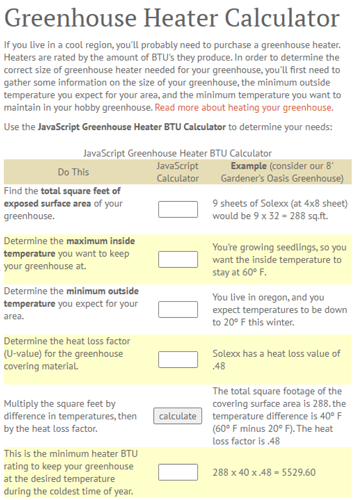How to Choose a Greenhouse Heater
If you have a power source in your greenhouse, adding a heater is a great way to expand your greenhouse garden's capabilities. Setting up a heater is relatively easy. By extending your growing season or allowing you to grow year-round, you can protect your favorite plants from extra-cold nights and continue growing all of your favorite vegetables through the winter - or both! Read to learn more about the requirements for heating a greenhouse, finding the necessary number of BTUs, choosing the type of heater, and alternative heating options.
Greenhouse Heating Requirements
Heating a greenhouse will be ineffective if your greenhouse covering is not insulated. Because of this, only Solexx greenhouses or those with twin-walled polycarbonate panels (such as Riga or Sunshine) should be heated. Here are some insulation comparisons of various types of greenhouse coverings. Also, it is best that the greenhouse frame is insulated to prevent heat loss. If you would like to improve insulation in your greenhouse, you can line the walls with bubble wrap.
Finding the Necessary Number of BTUs
 Heaters are rated by the number of BTUs (a measurement of heat) that they produce. It is important to pick a heater that has the proper amount of BTUs for your greenhouse; using a heater that produces more BTUs than needed will only waste energy and may cause your greenhouse to overheat. You should consult our heater calculator to find out how many BTUs you need based on the size of your greenhouse, your climate and desired greenhouse temperature. A greenhouse thermometer is a great way to monitor the temperatures in your greenhouse so that you know how much heat you need.
Heaters are rated by the number of BTUs (a measurement of heat) that they produce. It is important to pick a heater that has the proper amount of BTUs for your greenhouse; using a heater that produces more BTUs than needed will only waste energy and may cause your greenhouse to overheat. You should consult our heater calculator to find out how many BTUs you need based on the size of your greenhouse, your climate and desired greenhouse temperature. A greenhouse thermometer is a great way to monitor the temperatures in your greenhouse so that you know how much heat you need.
Choosing the Type of Greenhouse Heater
Several types of heaters are available, depending on the required number of BTUs and the desired fuel source. Electric heaters are available, as well as heaters that run on natural gas or propane. Operating costs for each of these options are fairly similar. If you decide to use a natural gas or propane heater, you have the option between vented and non-vented heaters. Generally, non-vented heaters are used because they are slightly less expensive and are adequate for most greenhouse situations. However, there are some areas that require that only vented heaters are used within structures, so you should check locally before making your decision. Vented heaters are also recommended for greenhouses producing sensitive plants, such as orchids or begonias. You can read more about all of our greenhouse heaters for sale here.
Alternatives to Using Heaters
If you’re looking to keep your greenhouse a little warmer at night spending money on heating, there are a couple non-heater options. The most simple option is to use some ten-gallon buckets filled with water. Paint one side of the bucket black and the other side white, and put a lid on the buckets. Place several of these buckets in your greenhouse, orienting the white sides toward the center. The white portion will help the light energy reflect throughout the greenhouse, while the black portion will absorb heat. This heat will be stored in the water until sundown and release slowly throughout the night. Another natural greenhouse heating option is to add several rabbits to your greenhouse. They will give off heat to warm the greenhouse while also providing natural fertilizer. Just make sure to regulate the greenhouse temperature to protect the bunnies from extreme heat or cold.
Click here for tips on reducing greenhouse heating costs.






